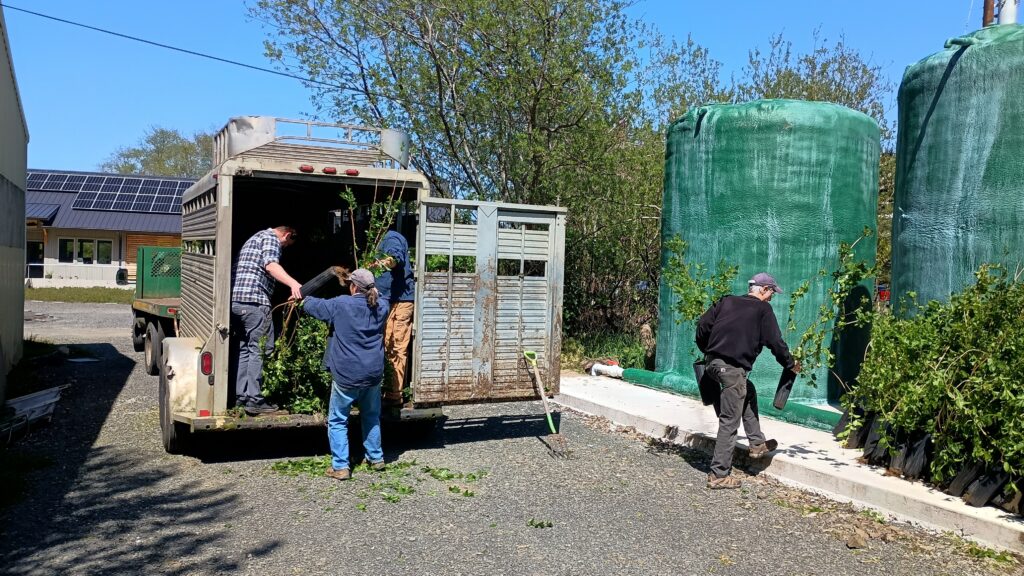In the late spring, NCLC’s stewardship team was contacted by its longtime partner, Tillamook Estuaries Partnership. At the end of the main planting season, TEP had a surplus of roughly 2,500 shrubs at their Native Plant Nursery in Tillamook that needed a home or they would be composted.
With the help of numerous volunteers, Circle Creek Habitat Reserve became that home.
The project of salvaging the shrubs, transporting them to the reserve near Seaside, and planting them across roughly two to three acres became known as Feathered Friends and Creekside Trends.
“We wanted to do a restoration project that was specifically targeting enhancing habitat for birds,” Stewardship Director Melissa Reich says. That includes adding beneficial native shrubs—such as elderberry, salmonberry, cascara, twinberry, and Pacific ninebark—in an area of Circle Creek that is currently dominated by reed canary grass, which doesn’t make for good habitat. Shrub habitat is also important for nesting and perching.

For most of May and into early June, NCLC’s various stewardship efforts, including Tidy Wild Tuesdays and Weed Warrior Wednesdays, became focused on getting the shrubs into the ground to capitalize on the remaining spring moisture.
“We were trying to get them in the ground before it got too hot and dry,” Melissa says. “And at the same time, the canary grass is growing aggressively.”
It took several trips to Tillamook to haul the thousands of shrubs to Circle Creek. NCLC board member Tammi Lesh even volunteered her horse trailer to transport more at one time.
Using a small grant from the Oregon Wildlife Foundation, the team fenced in the planting area to limit elk browsing. Then, they started to tuck the plants into their new home along the Wetland Walk trail at Circle Creek.
In addition to Tidy Wild Tuesdays, Weed Warrior Wednesdays, and other spontaneous activities, Land Steward Nick Bromen organized Restoration Rendezvous get-togethers on several Fridays in May and early June to supplement the planting efforts. In all, 165 volunteer hours were spent on the project—not including the transportation time.
“It was awesome to have such high interest and support from our volunteers, without whom we couldn’t have completed this project,” Nick says.
The restoration project also highlights the importance of NCLC’s partnership with TEP, as one of their North Oregon Restoration Partners (NORP). NCLC has been part of NORP for several decades.
“It’s a really wonderful program that grows native plants with coastal genetics; they have good root stock to compete with pasture grass and reed canary grass,” Melissa says. “They grow most of the plant material we use for restoration projects.”
To receive a discount on plant materials as a partner, NCLC contributes a certain amount of volunteer hours at TEP’s native plant nursery each year.
On Halloween of this year, the stewardship team is planning a Spooky Seed Sowing work party in partnership with TEP, and volunteers from the community are invited to don their favorite costume and spend a fun day in Tillamook. Stay tuned for more details about that event.

Future Habitat Restoration at Circle Creek
The planting activities that took place this spring and summer are only part of the larger Feathered Friends and Creekside Trends project planned for Circle Creek, which NCLC purchased in 2004. Located along the Necanicum River, the majority of the property is low elevation floodplain that was used historically as a dairy farm. As NCLC continues to steward the property towards a mosaic of forested wetlands and native scrub-shrub habitat, the team also aims to document the status and trends of bird populations associated with different habitat types undergoing active restoration.
It was awesome to have such high interest and support from our volunteers, without whom we couldn’t have completed this project.
Nick Bromen, NCLC Land Steward
“We’re hoping to do a larger bird-monitoring project in the future, because it’s been 20 years that we’ve been doing restoration at Circle Creek,” Melissa says. “All the property was once cow pasture, and we’ve been slowly restoring it. We want to understand better which species of birds are using the habitat we’re restoring, and how bird diversity—we expect—increases as a result of 20 years of restoration.”

The team submitted a grant application to the Cornell Lab of Ornithology’s Land Trust Bird Conservation Initiative. Although highly ranked, the grant was not awarded in this round, but they hope to apply again in the future.
Grant funding could potentially be used for acoustic recording units (ARUs) to record bird calls and help with identifying which species are present in different areas on the reserve.
Circle Creek has five different habitat types: Sitka-spruce swamp; maturing upland forest; young forest; scrub-shrub wetland; and remaining pasture. The recording units would be set up within the different habitat types and rotated around Circle Creek to get bird inventory, survey for rare species, and track variances between the areas that have been planted and those that haven’t, Nick says. The monitoring would provide even more definitive data about which treatments are most effective, while also informing future restoration efforts. Over time, the team also might plant trees within the enclosure areas to provide structural variation.
“With the planting of the cedars, spruces and shrubs at Circle Creek over the past 20 years, you can see firsthand that we’re starting to close in on the old cow pasture to reclaim the floodplain closer to its native condition,” Nick says. “The reed canary grass and blackberry are being shaded out in areas we’ve planted here. Bit by bit, with each restoration project completed at Circle Creek, NCLC’s vision for this habitat reserve is really coming along.”
Comments